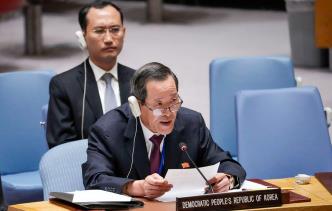
North Korean leader Kim Jong Un has defiance in his blood. It’s said his grandfather once asked what would happen if the United States defeated North Korea in war, to which his father answered: “If we lose, I will be sure to destroy the Earth. What good is the Earth without North Korea?”
President Trump has decided to confront what’s probably the most reckless, risk-taking regime on the planet. His hope for a diplomatic solution depends on convincing North Korea and China that he’s ready for the “fire and fury” of nuclear war should negotiations fail. If Hollywood were pitching the story, it would be “The Art of the Deal” meets “Dr. Strangelove.”
A careful look at the details of US military and diplomatic planning shows why this confrontation would be so delicate and dangerous. Despite Trump’s inflammatory rhetoric this week, the path ahead is really about finesse: Both the military and diplomatic paths require close cooperation with regional partners. The United States can’t go it alone in Korea, in either war or peace. The danger is that Trump’s rhetoric could destabilize partners more than adversaries.
Robert Work, a deputy defense secretary in the Obama administration who stayed on and just left the Pentagon, explains: “A preemptive war to protect our homeland from future attack is an option, but the major risks would be borne by South Korea and Japan, which face the threat of missile attacks today.”
Let’s start by examining the military option. “OPLAN 5027,” as it’s known, is a compendium of logistical details, but the basic premise is simple: The United States would fight alongside South Korea to gain control of the peninsula, and the Pentagon would need nearly two months to transport needed soldiers and equipment.
This protracted prep period would be a time of nuclear brinkmanship. If Trump decides that negotiations aren’t likely to succeed, he would presumably start moving materiel and troops from the United States, Europe and the Middle East. The cargo manifest would include armed drones, counter-battery artillery, communications and intelligence gear, scores of planes and many thousands of troops. The military calls it the “time-phased force and deployment List,” or TPFDL.
All the while, as the United States conducts this 45-to-60-day buildup, Seoul and its 10 million residents would be vulnerable to a preemptive North Korean attack. What would Pyongyang do as the assault force gathers? Bargain, or strike?
Significant civilian casualties would be inescapable if war comes. North Korea has thousands of artillery tubes just across the Demilitarized Zone. If attacked or threatened with decapitation, the regime could launch a barrage. The Pentagon estimates that on the first day, North Korea could fire up to 100,000 rocket and artillery rounds.
To protect the estimated 300,000 American civilians in Seoul from this artillery inferno, the Pentagon plans to stage “noncombatant evacuation operations.” Organizing planes and ships for so many people would be a nightmare, as would the chaos among those left behind. Analysts estimate that an additional 1 million non-Koreans may live in the country, including many Chinese. How would they get out? China might help in an evacuation, but at what political price?
The United States could try a lightning strike to preempt a North Korean attack, perhaps using cyber and other exotic weapons. But the Pentagon cautions policymakers that there isn’t a way to guarantee that North Korea couldn’t launch a nuclear missile in response to such an attack. It would be a cosmic roll of the dice.
What about diplomatic options, if war is so scary? The Trump administration has been working for months to encourage China to help broker negotiations. To woo Beijing, Secretary of State Rex Tillerson has pledged that the United States doesn’t seek regime change or collapse in Pyongyang, won’t support any quick Korean reunification and doesn’t want to send US troops north of the 38th parallel. This formula satisfies Beijing’s conditions about the future of the peninsula, and it should assuage some of Kim’s worries, too.
Tillerson, who is driving Korea policy (at least when Trump isn’t tweeting or speaking publicly), told reporters that Kim can demonstrate he’s ready for talks by halting missile tests.
The table is set for negotiations. Sources knowledgeable about China say that party leaders are being briefed at their annual seaside retreat this month about possible tougher moves to squeeze Kim, including a cut in oil deliveries or even a naval blockade.
At a moment that requires subtlety, Trump unwisely amped up his rhetoric once more Thursday, warning the North Koreans of things “they never thought possible.” He talks like the promoter of a WWE wrestling match. But this is real.
via The Washington Post












